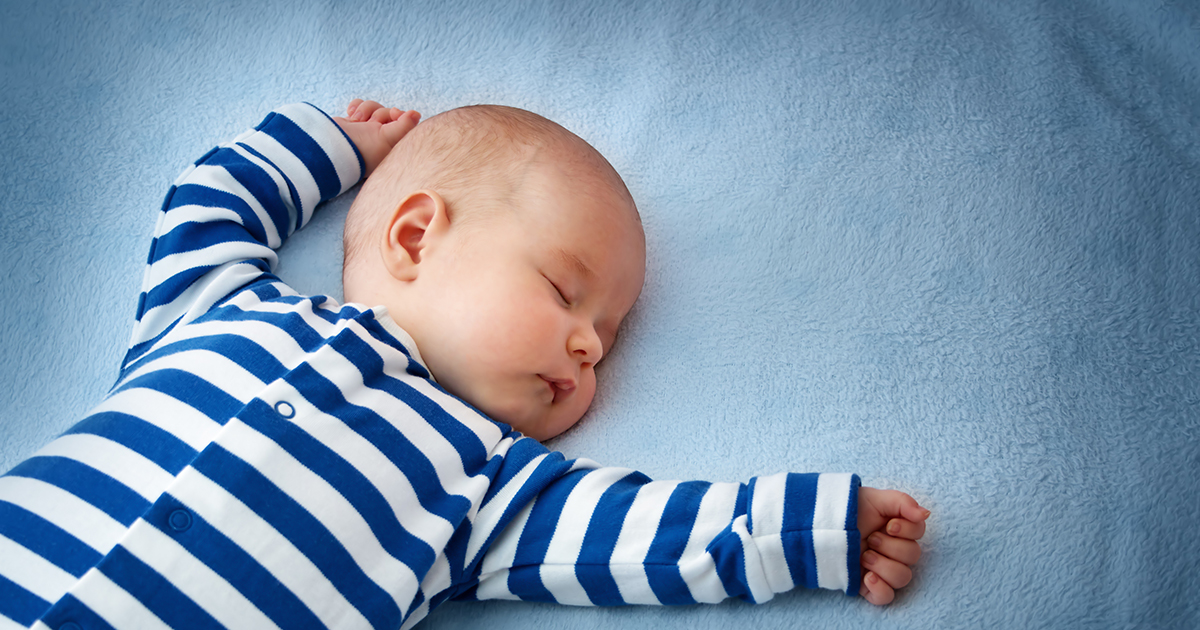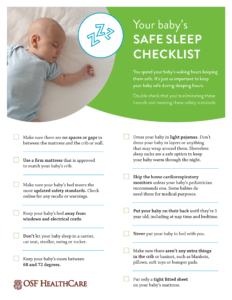
10 questions on how to put your baby to sleep
Parents work hard to keep their baby safe during waking hours. But it’s just as important to keep your baby safe during sleeping hours, as well. It can be hard to know what safe sleep is for your baby.
Luis Garcia, MD, a pediatrician at OSF HealthCare, answered the top 10 questions he gets from parents.
How do you put a baby to sleep?
The best way for your baby to sleep is to put them on their back. Even if your baby spits up, they likely won’t choke. The trachea (the breathing pipe connected to the lungs) is in front of the esophagus (the food pipe connected to the stomach). So, your baby will likely be able to swallow any spit up down the esophagus.
Dr. Garcia also said you should put your baby to bed before they’re asleep.
“Many times babies fall asleep while they are eating. But, the best sleep pattern is to cut them off before they have completely fallen asleep. When they’re groggy and almost asleep, then you can put them in their bed.
“Our bodies like routine. The sooner you start putting your baby to bed before they’re asleep, the easier it will be,” Dr. Garcia said.
How much sleep does a newborn need?
“They sleep a lot,” Dr. Garcia said.
Your baby needs about 16-17 hours of sleep per day when they’re first born. And they’ll only sleep about one to two hours at a time. They need to wake up often to eat.
At about four to six months of age they’ll sleep less often.
When do babies sleep through the night?
Most parents eagerly await the night when they can get a full night’s sleep.
“Usually between four to seven months old your baby will sleep around six consecutive hours (or more if you’re lucky!),” Dr. Garcia said.
It’s fine if they don’t make it through the night by four to seven months.
“Even if they wake up hungry in the night at six or seven months, that doesn’t mean something is wrong. Every baby is different and is on their own routine,” Dr. Garcia said.
Where should my baby sleep?
Your baby should sleep in a bed of their own, like a bassinet or crib.
You should avoid letting your baby sleep in anything that isn’t their bed, like a swing or car seat.

Is your baby sleeping safely?
Print the safe sleeping checklist
Don’t put the baby in your bed. You should never co-sleep with your baby.
As a parent, you will probably experience more separation anxiety than your baby. It may help to keep your baby’s crib or bassinet close to your bed.
You can decide to move them out of your room and into their own room between six and 12 months.
Baby cribs should have nothing in them: no pillow, no blankets, no stuffed animals, nothing.
Babies should always sleep on a flat sleep surface.
Propping your baby’s head up will not help them to digest better or avoid reflux. Your baby’s chance of choking may increase if they’re propped up.
Their head may roll to one side if they’re propped up, which is also a suffocation hazard.
How do you prevent SIDS?
Sudden infant death syndrome (SIDS) is the unexpected death of an infant from one month to one year old. Fortunately, most of the causes are preventable. It’s important to avoid anything that will increase the risk of or lead to suffocation.
Main causes of SIDS include:
Exposure to smoke, like second-hand smoke
Having them in a position that isn’t flat (for example, in a swing or car seat)
Leaving your baby unsupervised
Including any stuffed animals, blankets or pillows in the crib
It’s much more rare for an infant to die of an undiscovered congenital condition. Listen to your provider and follow the American Academy of Pediatrics’ Back to Sleep program (AAP). You will help reduce the risk of SIDS significantly.
When does the risk of SIDS decrease?
As the baby grows, the risk of dying of SIDS decreases. The baby will gain motor skills. So they’re less likely to get stuck in a position that they can’t get out of.
There is a marked decrease of SIDS risk at six months old. By then your baby usually can roll from front to back and back to front.
“No matter what, you never stop worrying about your children. That’s normal. That’s being a parent. That’s part of the journey,” Dr. Garcia said.
When can babies sleep on their stomach?
When babies sleep on their stomachs, they’re more likely to inhale carbon dioxide that they exhaled. So it’s important to always start them on their back.
However, babies are going to be babies. They sometimes roll over on their own in the middle of sleeping.
If they’re able to roll over onto their tummy, they should be able to roll over onto their back again. That usually happens around five months old.
If they roll on their tummy before five months old, you can check on them to make sure they’re fine. If something’s not right, you can roll them back over.
How do I sleep train my baby?
There is no specific formula for sleep training your baby. The baby sleep schedule is a spectrum. There are many things that are normal for babies to do when they are asleep.
Babies’ routines change as they grow and enter different phases. Maybe your infant was sleeping through the night, but they’ve started waking up more often. It’s not uncommon to experience baby sleep regression.
Dr. Garcia said there’s not usually a specific reason for this, but it can be frustrating for parents. Keeping up regular routines of naps and bedtime at the same time may help. And trying different feeding tips may help, as well.
Why do babies fight sleep?
“Babies don’t understand what tired means. They just know they don’t feel right, so they fuss,” Dr. Garcia said.
Napping and going to bed at the same time each day can help to keep babies on a regular schedule. Try to avoid keeping your baby up when they’re overtired. This may make them fussier.
When can a baby sleep with a blanket?
Your baby can sleep with a blanket and pillow between 12 and 18 months old. As long as they’re able to walk, they’ll be able to get themselves untangled.
Similarly, many parents wonder if sleep sacks are safe.
Dr. Garcia calls this a controversial topic. Providers don’t necessarily agree on one answer on the safety of baby sleep sacks and the AAP doesn’t have any official recommendations, except that babies should never wear or be covered by anything weighted.
“The best bassinet is a boring one. Just a plain mattress, a well-fitted sheet and nothing else,” Dr. Garcia said.
If you have any questions about your baby’s sleep, their provider is always the first one to turn to.